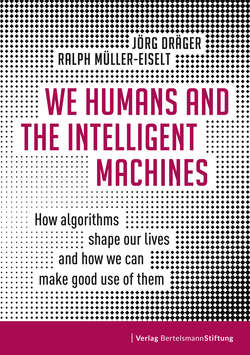Читать книгу We Humans and the Intelligent Machines - Jörg Dräger - Страница 28
На сайте Литреса книга снята с продажи.
ОглавлениеWhat algorithms can do for us
A world without algorithms is hardly imaginable today. They have crept almost imperceptibly into our lives. Intelligent machines are now used almost everywhere that information is available electronically. The following nine chapters show the extent to which they are deployed and the impact they have. This second part uses practical examples to show how algorithms can make life better and more just for each of us and for society as a whole. Yet people and machines do not always complement each other in a meaningful way. Their interaction can also have negative consequences for individuals and society – be it unintentionally or by malice aforethought.
An algorithm for algorithms
It is precisely this tension that interests us. We want to examine those algorithmic systems that influence whether people can participate in society. For better or for worse. With consequences that concern us all, because they bring either social progress or serious disadvantages. Not all algorithms are truly relevant to society. Neither the spell checker in word processing software nor a car rental company’s computer-driven fleet management system will shake the foundations of communal life. They do not need public discourse – which, on the other hand, is indispensable if algorithms are to have a say in asylum procedures or prison sentences.
To select the examples in the following chapters we used an “algorithm for algorithms” developed by researchers Kilian Vieth and Ben Wagner (see Chapter 14), which measures the relevance to society as a whole. Its main criteria: Are people being evaluated by the algorithmic system? How dependent are they on the result? How much political and economic power does the organization using the algorithm have? What is the system’s scope? The answers are assigned cumulative scores. The higher the overall result, the more relevant a system is to social participation. And, consequently, the more attention it deserves – not only in this book.
Creating order in the jungle of algorithms
The second part of this book dives into the world of practical applications. It looks at the impacts that algorithms can have on individuals and on society as a whole. We place more emphasis on clarity than on technical detail: Our focus is on the effect of the algorithms, not on their programming code. At the same time, we try to bring order to the jungle of different applications. The following nine chapters identify four impacts on the individual, four on society as a whole and one on our social interactions.
At the individual level (Chapters 5 to 8), algorithms can meet personal needs more effectively, provide fairer access to goods essential for social participation, expand human capabilities and create space for activities we are particularly good at or like. Possible downsides are manipulation, exclusion of weaker individuals, an algorithmic arms race and reckless efforts to achieve ever higher productivity.
At the societal level (Chapters 9 to 12), algorithms offer the potential to monitor the use of government services more accurately, distribute limited resources more efficiently, establish effective preventive measures for healthier and safer communities, and make fairer decisions. This is countered by risks such as excessive state intervention, the misappropriation of software, the weakening of social solidarity, and growing social inequality and discrimination. Last but not least, algorithms also influence personal relationships and our communication and values. They can strengthen cohesion, but also promote social polarization (Chapter 13).
